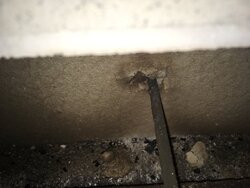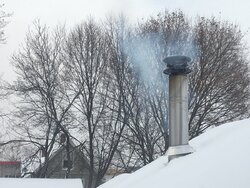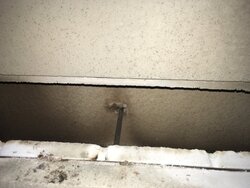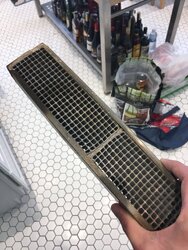Hey Everyone-
First, thanks for providing this lurker with a lot of great information. We burned non-cat stoves when I was younger, just installed a VC Encore into my first house that I renovated. Getting up to speed with catalyst burning over the last two weeks, but had a burn last night that had me real nervous...
I've been running hot on smaller-sized loads, trying to work to control it...
Fuel is sugar maple and some poplar - took down overhanging trees in May 2016 before I spent 20k on a new roof; has been covered with good air movement through a Northern Ohio summer. Seems plenty seasoned with cracks, but can't believe it'd be overly dry? Chimney is ~25ft with one slight 4ft bend section in the attic to get around a roof beam before exiting the roof.
Been getting the stove hot with small pieces and then down to light bed of coals before adding 3-4 splits east-west; let it catch then engage damper (cat chamber will fire) and close air control nearly (or completely) all the way. Even just these lighter loads, it will rise to 600 griddle plate with catalyst temp probe right in the middle.
Last night, we had wicked 20-30 mph winds as temps dropped to around 30; had been burning in the evening hot; finally died back to coals, but perhaps had too large a coal bed? Temp was down to 450 so I put 4 more splits in and since was already running hot (figured because of great draft) I damped and closed the air control all the way down from the get-go.
Well, crap. Stove top isn't too bad (600-650); but catalyst temp is near the top of "safe" range so I try to open the damper to allow some heat up the pipe.
Well, double crap - start getting a bit of smoke backfill from pipe section seams and a roaring fire! Close the damper back down, open the windows, turn on all the fans, and have my phone ready... Basically just watching this thing over-fire for two hours fully clamped down was scary - 750 stove top and cat probe just a micro-smidge above the upper limit...
I think by opening the damper to let heat up the pipe with the air control choked I had a hungry fire sucking air back down, essentially a hot-stove back-puff?
I've since learned about the ash trick as well as keeping a sopping-wet log around... Two questions remain, though:
First- damage? Nothing on the external stove or piping was glowing, so hopefully I'm okay. However, the fire brick on the inside was a-glow, though... Can the catalyst also handle being at max or a tiny bit above (I guess how accurate is the standard probe) for 1-2 hours? Hopefully not a $200 catalyst mistake, really hope nothing warped...
Second- what the heck? How can I keep this stove from firing so hot? I'm going to start over with very small loads, let coals burn down more. Definitely don't have ash tray open; I'll try the dollar-bill trick once I get home but it's only two weeks old! I can't fathom the wood is that dry, but it is smaller-size splits - still... Do I need to have installers back out to have a look? Air leak somewhere? Also noting the intake holes to completely choke off if it should happen again, but I want to prevent here....
Thanks for the help!
First, thanks for providing this lurker with a lot of great information. We burned non-cat stoves when I was younger, just installed a VC Encore into my first house that I renovated. Getting up to speed with catalyst burning over the last two weeks, but had a burn last night that had me real nervous...
I've been running hot on smaller-sized loads, trying to work to control it...
Fuel is sugar maple and some poplar - took down overhanging trees in May 2016 before I spent 20k on a new roof; has been covered with good air movement through a Northern Ohio summer. Seems plenty seasoned with cracks, but can't believe it'd be overly dry? Chimney is ~25ft with one slight 4ft bend section in the attic to get around a roof beam before exiting the roof.
Been getting the stove hot with small pieces and then down to light bed of coals before adding 3-4 splits east-west; let it catch then engage damper (cat chamber will fire) and close air control nearly (or completely) all the way. Even just these lighter loads, it will rise to 600 griddle plate with catalyst temp probe right in the middle.
Last night, we had wicked 20-30 mph winds as temps dropped to around 30; had been burning in the evening hot; finally died back to coals, but perhaps had too large a coal bed? Temp was down to 450 so I put 4 more splits in and since was already running hot (figured because of great draft) I damped and closed the air control all the way down from the get-go.
Well, crap. Stove top isn't too bad (600-650); but catalyst temp is near the top of "safe" range so I try to open the damper to allow some heat up the pipe.
Well, double crap - start getting a bit of smoke backfill from pipe section seams and a roaring fire! Close the damper back down, open the windows, turn on all the fans, and have my phone ready... Basically just watching this thing over-fire for two hours fully clamped down was scary - 750 stove top and cat probe just a micro-smidge above the upper limit...
I think by opening the damper to let heat up the pipe with the air control choked I had a hungry fire sucking air back down, essentially a hot-stove back-puff?
I've since learned about the ash trick as well as keeping a sopping-wet log around... Two questions remain, though:
First- damage? Nothing on the external stove or piping was glowing, so hopefully I'm okay. However, the fire brick on the inside was a-glow, though... Can the catalyst also handle being at max or a tiny bit above (I guess how accurate is the standard probe) for 1-2 hours? Hopefully not a $200 catalyst mistake, really hope nothing warped...
Second- what the heck? How can I keep this stove from firing so hot? I'm going to start over with very small loads, let coals burn down more. Definitely don't have ash tray open; I'll try the dollar-bill trick once I get home but it's only two weeks old! I can't fathom the wood is that dry, but it is smaller-size splits - still... Do I need to have installers back out to have a look? Air leak somewhere? Also noting the intake holes to completely choke off if it should happen again, but I want to prevent here....
Thanks for the help!





